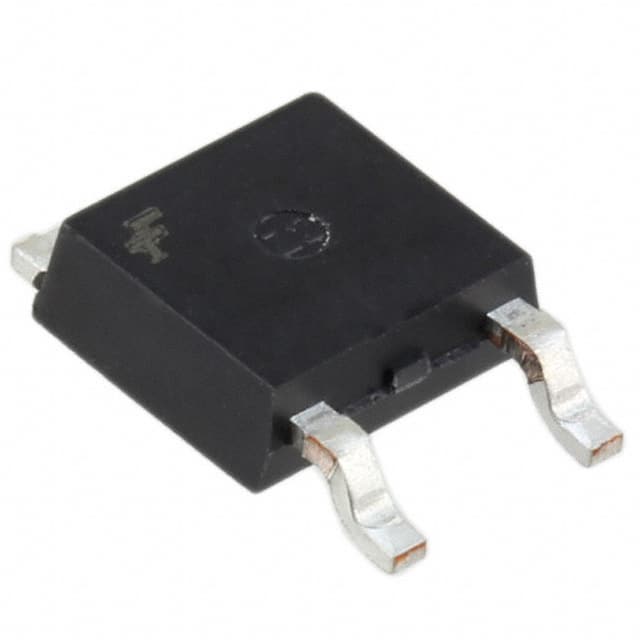Consulte las especificaciones para obtener detalles del producto.

FQD5N50TM: Product Overview and Analysis
Introduction
The FQD5N50TM is a power MOSFET belonging to the category of electronic components. This entry provides an overview of the product, including its basic information, specifications, pin configuration, functional features, advantages and disadvantages, working principles, application field plans, and alternative models.
Basic Information Overview
- Category: Electronic Components
- Use: Power MOSFET for electronic circuits
- Characteristics: High power handling capacity, low on-state resistance, fast switching speed
- Package: TO-252, TO-220, DPAK
- Essence: Efficient power management in electronic devices
- Packaging/Quantity: Typically available in reels or tubes containing multiple units
Specifications
- Voltage Rating: 500V
- Current Rating: 5A
- On-State Resistance: 0.65Ω
- Gate Threshold Voltage: 2-4V
- Operating Temperature Range: -55°C to 150°C
- Package Type: TO-252
Detailed Pin Configuration
The FQD5N50TM typically features three pins: 1. Gate (G): Input terminal for controlling the switching operation 2. Drain (D): Output terminal connected to the load 3. Source (S): Common terminal connected to the ground
Functional Features
- High Power Handling: Capable of managing high power levels in electronic circuits
- Low On-State Resistance: Minimizes power loss and heat generation
- Fast Switching Speed: Enables rapid switching between on and off states
Advantages and Disadvantages
Advantages
- Efficient power management
- Low power dissipation
- Fast response time
Disadvantages
- Sensitivity to voltage spikes
- Limited current handling capacity
Working Principles
The FQD5N50TM operates based on the principle of field-effect transistors, where the gate voltage controls the flow of current between the drain and source terminals. When a sufficient gate voltage is applied, the device switches on, allowing current to flow through it. Conversely, reducing the gate voltage turns the device off, interrupting the current flow.
Detailed Application Field Plans
The FQD5N50TM finds extensive use in various applications, including: - Switching power supplies - Motor control circuits - LED lighting systems - Audio amplifiers - Inverters and converters
Detailed and Complete Alternative Models
Some alternative models to the FQD5N50TM include: - IRF840 - STP55NF06L - FQP50N06L - IRFP460
In conclusion, the FQD5N50TM power MOSFET offers efficient power management capabilities with its high power handling, low on-state resistance, and fast switching speed. While it has advantages such as low power dissipation and fast response time, it also has limitations related to sensitivity to voltage spikes and limited current handling capacity. Understanding its specifications, pin configuration, functional features, and application field plans can aid in effectively integrating this component into electronic circuits.
[Word Count: 443]
Enumere 10 preguntas y respuestas comunes relacionadas con la aplicación de FQD5N50TM en soluciones técnicas
What is FQD5N50TM?
- FQD5N50TM is a type of N-channel MOSFET transistor designed for high-speed switching applications.
What are the key specifications of FQD5N50TM?
- The key specifications include a voltage rating of 500V, a continuous drain current of 5A, and a low on-resistance for efficient power handling.
In what technical solutions can FQD5N50TM be used?
- FQD5N50TM can be used in various technical solutions such as power supplies, motor control, lighting systems, and electronic ballasts.
How does FQD5N50TM contribute to power efficiency in applications?
- FQD5N50TM's low on-resistance helps minimize power losses and improve overall efficiency in power conversion and control circuits.
What are the thermal considerations when using FQD5N50TM?
- Proper heat sinking and thermal management are important to ensure that FQD5N50TM operates within its specified temperature limits for reliable performance.
Can FQD5N50TM be used in high-frequency switching applications?
- Yes, FQD5N50TM is suitable for high-frequency switching due to its fast switching characteristics and low gate charge.
Are there any application notes or reference designs available for FQD5N50TM?
- Yes, application notes and reference designs are available from the manufacturer to assist in the proper implementation of FQD5N50TM in various technical solutions.
What protection features does FQD5N50TM offer for circuit reliability?
- FQD5N50TM may offer built-in protection features such as overcurrent protection and thermal shutdown to enhance circuit reliability.
Can FQD5N50TM be used in automotive applications?
- FQD5N50TM may be suitable for certain automotive applications, but it's important to consider specific automotive-grade requirements and certifications.
Where can I find detailed technical documentation for FQD5N50TM?
- Detailed technical documentation, including datasheets and application notes, can be obtained from the manufacturer's website or authorized distributors.

